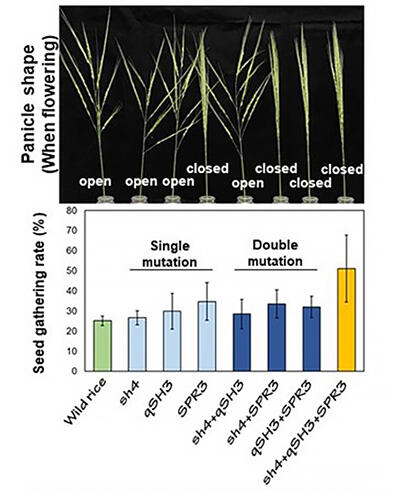The research group of Associate Professor Ryo Ishikawa, Professor Takashige Ishii, and Professor Kazuya Inoue of the Department of Bioresource Science in the Graduate School of Agricultural Science at Kobe University, in collaboration with the National Institute of Genetics (Japan), the University College London (UK), the University of Warwick (UK), Yezin Agricultural University (Myanmar), and the Cambodian Ministry of Agriculture, Forestry and Fisheries, announced that they have found that the effects of mutations in three genes during the initial stages of the birth of cultivated rice from wild rice may have made it more difficult for seeds to drop and scatter (reduced seed shattering). It is expected to be a result that will lead to the development of rice varieties with low seed shattering rates. The results were published in the June 22nd issue of the "Proceedings of the National Academy of Science of the United States of America."

The panicle shapes of 8 plants (above) and the seed gathering rate for each plant when grown on cultivated land (below).
Ishikawa et al. A stepwise route to domesticate rice by controlling seed shattering and panicle shape.
https://www.pnas.org/doi/10.1073/pnas.2121692119
Provided by Kobe University
Cultivated rice (Oryza sativa) is thought to have originated from wild rice (Oryza rufipogon), a weed, and that it was first cultivated by ancient hunter-gatherers who selected and cultivated wild rice plants with characteristics favorable for farming.
Wild rice has a seed shattering tendency that cause seeds to be dispersed for reproduction. However, cultivation requires the suppression of this tendency to drop seeds before harvest.
For rice it was reported in 2006 that mutations in the sh4 gene were involved with seed shedding. But, in 2016, the research group clarified that the sh4 gene mutation alone could not suppress seed shedding and that other gene mutations may be involved.
In this research, the group searched for other genes involved in this seed shattering tendency in order to understand how cultivation was triggered during the initial process of rice cultivation. First, genetic analysis using an isolated population obtained by crossing wild rice and cultivated rice revealed that a new mutation in the qSH3 gene is necessary to suppressing seed shattering. This mutation was preserved in most of the cultivated rice plants in the world.
It was then found that the seed shedding tendency could not be removed when the two mutations, in the sh4 and qSH3 genes, were introduced into wild rice. The seed shedding tendency functions via the formation of detached layers in the rice husk, and mutations in these two genes only inhibited a small portion of the detached layers around the vascular bundles. Additionally, mutations of the qSH3 gene alone also did not inhibit the detached layers.
Therefore, the research group focused on the differences between wild rice and cultivated rice in the shape of the ears of rice on the plant. In wild rice the ears open when they emerge, but in cultivated rice the ears are closed, and this change is caused by a mutation in the SPR3 gene. For these three genes, the eight combinations of mutations in each of the genes were produced in crosses, and their respective harvest rates were compared.
The results showed that mutations in just one or two of the genes did not significantly change the harvest rate, and the harvest rate dramatically increased only when the three mutations were combined. A structural dynamics analysis on the inhibition of the ear-closing detached layers showed that, in closed ears, the load from the seed base to the delamination due to gravity was smaller than when the ears were open.
According to Associate Professor Ishikawa, "It is more difficult for seeds in the rice of today to drop and further mutations have accumulated in the evolutionary process, but we believe that the mutations revealed in this research occurred at the very beginning of domestication. If all of these can be clarified, then we expect that we will be able to determine the route by which rice came to Japan. We also believe that these genetic mutations can be used to breed varieties that meet our needs, including the needs of foreign countries."
This article has been translated by JST with permission from The Science News Ltd.(https://sci-news.co.jp/). Unauthorized reproduction of the article and photographs is prohibited.




